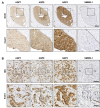Aquaglyceroporins in Human Breast Cancer
- PMID: 37681917
- PMCID: PMC10486483
- DOI: 10.3390/cells12172185
Aquaglyceroporins in Human Breast Cancer
Abstract
Aquaporins are water channels that facilitate passive water transport across cellular membranes following an osmotic gradient and are essential in the regulation of body water homeostasis. Several aquaporins are overexpressed in breast cancer, and AQP1, AQP3 and AQP5 have been linked to spread to lymph nodes and poor prognosis. The subgroup aquaglyceroporins also facilitate the transport of glycerol and are thus involved in cellular metabolism. Transcriptomic analysis revealed that the three aquaglyceroporins, AQP3, AQP7 and AQP9, but not AQP10, are overexpressed in human breast cancer. It is, however, unknown if they are all expressed in the same cells or have a heterogeneous expression pattern. To investigate this, we employed immunohistochemical analysis of serial sections from human invasive ductal and lobular breast cancers. We found that AQP3, AQP7 and AQP9 are homogeneously expressed in almost all cells in both premalignant in situ lesions and invasive lesions. Thus, potential intervention strategies targeting cellular metabolism via the aquaglyceroporins should consider all three expressed aquaglyceroporins, namely AQP3, AQP7 and AQP9.
Keywords: AQP; aquaglyceroporin; aquaporin; breast cancer; metastasis.
Conflict of interest statement
The authors declare no conflict of interest.
Figures




References
-
- Montiel V., Bella R., Michel L.Y.M., Esfahani H., De Mulder D., Robinson E.L., Deglasse J.P., Tiburcy M., Chow P.H., Jonas J.C., et al. Inhibition of aquaporin-1 prevents myocardial remodeling by blocking the transmembrane transport of hydrogen peroxide. Sci. Transl. Med. 2020;12:eaay2176. doi: 10.1126/scitranslmed.aay2176. - DOI - PubMed
MeSH terms
Substances
LinkOut - more resources
Full Text Sources
Medical

